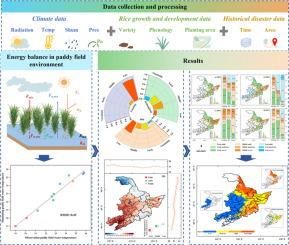当前位置:
X-MOL 学术
›
Agric. For. Meteorol.
›
论文详情
Our official English website, www.x-mol.net, welcomes your
feedback! (Note: you will need to create a separate account there.)
Hazard assessment of rice cold damage based on energy balance in paddy field
Agricultural and Forest Meteorology ( IF 5.6 ) Pub Date : 2024-09-14 , DOI: 10.1016/j.agrformet.2024.110233 Xueke Yan , Ying Guo , Bing Ma , Yunmeng Zhao , Suri Guga , Jiquan Zhang , Xingpeng Liu , Zhijun Tong , Chunli Zhao
Agricultural and Forest Meteorology ( IF 5.6 ) Pub Date : 2024-09-14 , DOI: 10.1016/j.agrformet.2024.110233 Xueke Yan , Ying Guo , Bing Ma , Yunmeng Zhao , Suri Guga , Jiquan Zhang , Xingpeng Liu , Zhijun Tong , Chunli Zhao

|
Cold stress seriously affects rice yield in Northeast China and, as a result of climate change, there are new trends in the characterization of cold damage. Accurate simulation of water temperature in paddy fields and assessment of cold damage hazard can contribute to improving the accuracy of agrometeorological disaster risk assessment in the context of climate change. Hence, in this study, first, we simulated the water temperature of paddy fields based on the paddy field energy-balance model and evaluated the simulation results. Subsequently, a composite cooling-degree-day (CCDD) indicator for rice fields was constructed based on water and air temperatures to characterize cold stress and identify cold damage events. Finally, a cold damage hazard-assessment model was constructed for rice based on the frequency and intensity of cold damage to assess cold damage hazard in Northeast China from 1979 to 2018. The results showed that the root-mean-square error between simulated and observed water temperatures of the rice field energy-balance model was 0.45, which means that the model accurately simulated the water temperature of the rice field on a large spatial scale. In 2004, cold damage to late-maturity rice accounted for 30% of the total study area, which was one of the years with most severe cold damage in late-maturity rice-growing areas thus far in the 21st century. Water temperature affected 76.4% of the area in 2004, and was related to radiation and saturated vapor pressure. The low-hazard areas accounted for more than 20% in 2009–2018, and the high-hazard areas were still higher than 10%, indicating that the threat of cold damage in the northeastern region of China remained severe as the climate has become increasingly warm.
更新日期:2024-09-14































 京公网安备 11010802027423号
京公网安备 11010802027423号